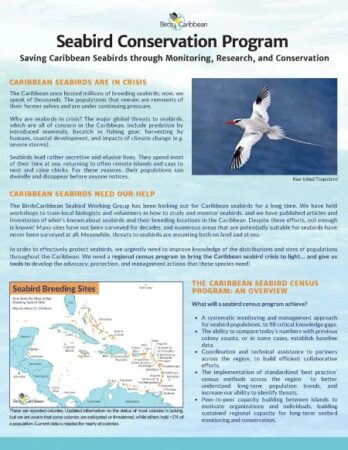Regional Seabird Census
 In order to effectively protect seabirds, we urgently need to improve knowledge of the distributions and sizes of populations throughout the Caribbean. We need a regional census program to bring the Caribbean seabird crisis to light and give us tools to develop the advocacy, protection, and management actions that these species need!
In order to effectively protect seabirds, we urgently need to improve knowledge of the distributions and sizes of populations throughout the Caribbean. We need a regional census program to bring the Caribbean seabird crisis to light and give us tools to develop the advocacy, protection, and management actions that these species need!
We have some great resources to help you during the Regional Seabird Census. Find what you need on this page using the links below:
Stakeholder Engagement
Webinar Series
Quizzes
Tools
Census Data Sheet
Regional Census Participants
Stakeholder Engagement
The BirdsCaribbean Seabird Working Group held a half-day workshop in December 2021 to collect updates from each island nation on their seabird resources, monitoring and conservation. We called this event “Seabird Fest.”
The event generated interest in seabird monitoring, provided updated information of the status of seabird monitoring in the region, and assessed the high level of interest in a pan-Caribbean seabird census in 2023-2024. The results of Seabird Fest are reported in the May 2022 BirdsCaribbean Seabird Working Group Newsletter.
Webinar Series
In May 2022, the SWG began a series of webinars focusing on the techniques required to survey seabirds in the Caribbean. The webinars started with the basics, and are progressing to more specialized topics related to monitoring. The intent is to help practitioners around the region prepare for engagement in the 2023-2024 regional census.
Caribbean Seabird Identification
Presented by J. Christopher Haney this webinar is a basic overview on identifying the Caribbean’s breeding seabirds.
Basic concepts in seabird monitoring and census design
Presented by Ann Sutton and Hannah Madden, this webinar provides an introduction to monitoring Caribbean seabirds. It includes defining your question, levels of monitoring, survey design, counts from the sea and from land, minimizing disturbance, assessing stage in the nesting cycle.
Field methods for seabird surveys
Presented by Natalia Collier this webinar provides details on basic methods of monitoring common species and habitats. It covers flush counts, subsampling, vantage point counts, etc. taking into account behaviors of various species. It describes strategies for where and how to find nests. It also covers a discussion or minimizing disturbance whilst making adjustments for level of experience and observer bias.
Acoustic methods for surveying burrow nesting seabirds
Presented by Matthew McKown (Conservation Metrics) and Léo Papet (Biophonia), and Caribbean seabird conservationist Ajhermae White (Montserrat Department of Environment) this webinar provides an overview of methods to monitor and census seabirds with acoustics.
Aerial methods for monitoring seabird populations
Presented by Dr. Rhiannon Austin (University of Liverpool) primate biologist and co-founder of both ‘Conservation Drones’ and ‘Conservation AI’ Professor Serge Wich (Liverpool John Moores University), this webinar gives us a general overview of drones and their use for surveying seabirds. It also provides a discussion of field considerations, species and habitat suitability, and uses a series of case studies to provide real-life examples. Finally there is an introduction to automated methods for handling drone imagery.
Handling seabird census data
Presented by Dr. Rhiannon Austion and Yvan Satge, this webinar focuses on data collection, management, and storage. Information about the types of data that can be collected is provided as well as suggestions for sharing seabird survey data.
“Seabird Hours”
Webinars in a discussion format with presentations on active projects
Species Hour #1: Tree-nesters Pelicans, Frigatebirds, Boobies, Cormorants
A discussion with Caribbean conservationists experienced in surveying these species. During this webinar we discussed the different methods being used to survey large tree-nesting seabird species, as well specific considerations and recommendations for the Caribbean.
Species Hour #2: Cavity-nesters
This webinar discussed survey methods for Caribbean cavity nesting Seabirds, including tropicbirds, shearwaters and petrels. The discussion includes insights from conservationist experienced in surveying these species groups and provides helpful tips to make you surveys of cavity nesters run smoothly.
Quizzes
Test your knowledge of Caribbean seabirds and field methods with our quizzes, which are linked to our webinar topics! Watch the webinar series to find all the answers (follow the links below for each quiz).
Seabirds of the Caribbean – seabird identification
Field Methods for Seabird Surveys
Adventures in Dataland – data collection and management
Tools
Please see the Seabird Resources page for access to historical seabird information, monitoring manuals and identification aids.
Our Census Data Sheet
We have prepared standardized data sheets which can be used either in the field or as a guide for the types of information the census should include. You may already have a form you use or a well-worn notebook; any format is fine as long as it includes the key elements found in the standardized data sheet.
It’s important everybody collects the same types of information found in the data sheet, such as GPS points, names of observers, species, and number of apparently occupied nests. Using standardized information will allow for easier and more relevant comparison of results across the region.
Once you’ve collected your field data, you’ll need to enter it into our standardized reporting database so we can easily compile and compare everybody’s data.
These CSC23/24 datasheets may be found in our shared Google Drive folder: https://drive.google.com/drive/folders/1PVU7hdPy0gjotO2lA86EMmDPioqjLRUi
Several files are provided:
- Field data sheets for simple counts (the most common type of survey), available in English, French, and Spanish
- Field data sheets for detailed counts (sub-sampling plots or transects), available in English
- Reporting database (to report your finalized and cleaned up data), available in English, French, and Spanish
Once you have finished your surveys, send your completed reporting databases to caribbeanseabirdsurveys@gmail.com.
Regional Census Participants
Are you planning on participating in the 2023-2024 Regional Census? Let us know! Please contact our census Coordinator, Louise Soanes, at caribbeanseabirdsurveys@gmail.com

